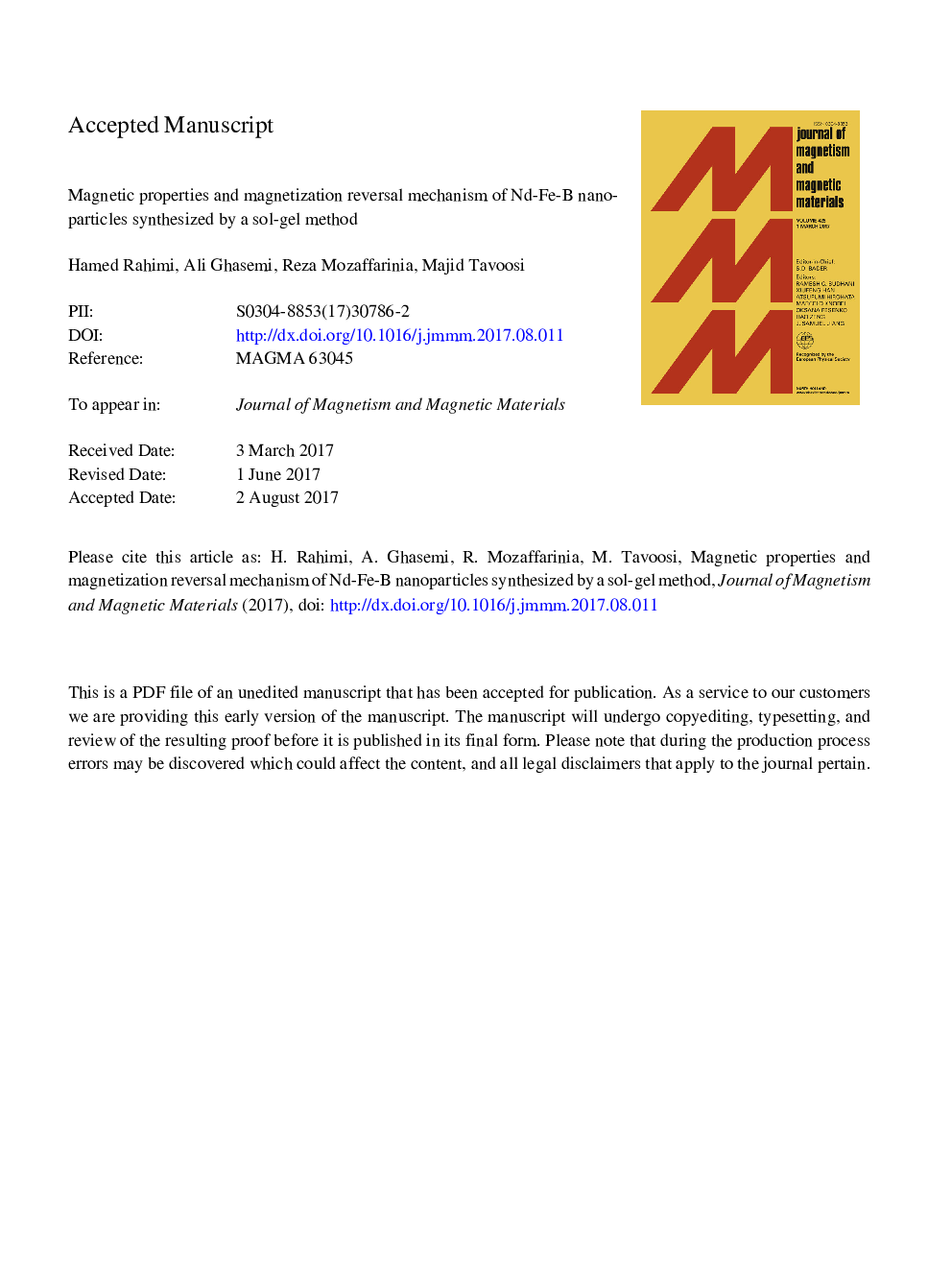| کد مقاله | کد نشریه | سال انتشار | مقاله انگلیسی | نسخه تمام متن |
|---|---|---|---|---|
| 5490088 | 1524777 | 2017 | 24 صفحه PDF | دانلود رایگان |
عنوان انگلیسی مقاله ISI
Magnetic properties and magnetization reversal mechanism of Nd-Fe-B nanoparticles synthesized by a sol-gel method
دانلود مقاله + سفارش ترجمه
دانلود مقاله ISI انگلیسی
رایگان برای ایرانیان
موضوعات مرتبط
مهندسی و علوم پایه
فیزیک و نجوم
فیزیک ماده چگال
پیش نمایش صفحه اول مقاله

چکیده انگلیسی
Nd-Fe-B oxide powders with various pH were prepared using chloride and nitrate precursors including NdCl3·6H2O, FeCl3·6H2O, H3BO3, Nd2O3, Fe(NO3)3·9H2O, HNO3, citric acid (CA), ethylene glycol (EG) by Pechini type sol-gel method. The pH of chloride and nitrate base sols were 0 and 2.2, respectively. Mixed oxide powders were obtained by calcination and annealing the gels. These oxides by using a reduction-diffusion process under high vacuum and employing CaH2 as reducing agent at 800 °C were hated to prepare Nd2Fe14B nanoparticles. The role of pH on phase, morphologies, microstructure, and magnetic properties of the powders were investigated. The results show that with a decrease in pH, the average particle size and coercivity of Nd-Fe-B oxide powders were decreased and increased, respectively. Nd2Fe14B nanoparticles were formed successfully after reduction process. The average particle size of reduction treated products were 30 and 65 nm for powders which made of chloride and nitrate base metal salts, respectively. Final powders which made of chloride and nitrate base metal salts had a saturation magnetization of 127.7 emu/g and 122.8 emu/g while the coercivity of samples were 3.32 kOe and 1.82 kOe, respectively. The experimental results in the angular dependence of coercivity indicated that the normalized coercivity of the permanent magnets Hc(θ)/Hc(0) obeys the 1/cosθ law and intermediate between the 1/cosθ law and Stoner-Wohlfarth formula for different Nd2Fe14B magnets which made of nitrate and chloride base metal salts, respectively. Also, the results show that different Nd2Fe14B magnets which made of nitrate and chloride base metal salts had the maximum energy product of 5 and 16 MGOe, respectively. The Henkel plot showed that magnetic phases in synthesized NdFeB magnets which made of chloride and nitrate base metal salts were coupled by exchange and dipolar interactions, respectively. Different average particle size, morphology and microstructure were the reasons for variation of magnetic properties.
ناشر
Database: Elsevier - ScienceDirect (ساینس دایرکت)
Journal: Journal of Magnetism and Magnetic Materials - Volume 444, 15 December 2017, Pages 111-118
Journal: Journal of Magnetism and Magnetic Materials - Volume 444, 15 December 2017, Pages 111-118
نویسندگان
Hamed Rahimi, Ali Ghasemi, Reza Mozaffarinia, Majid Tavoosi,